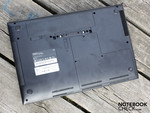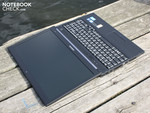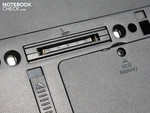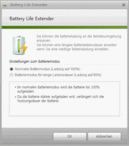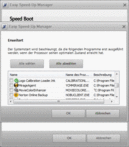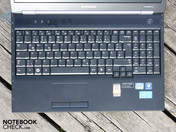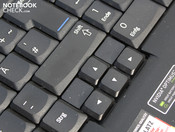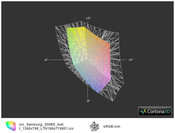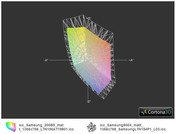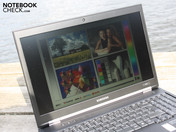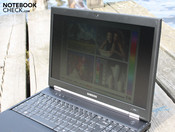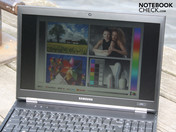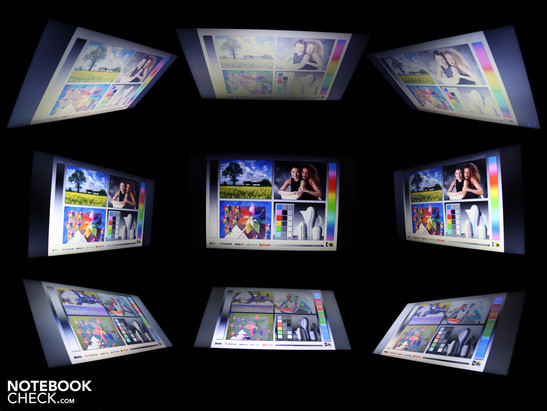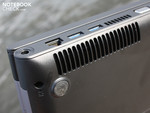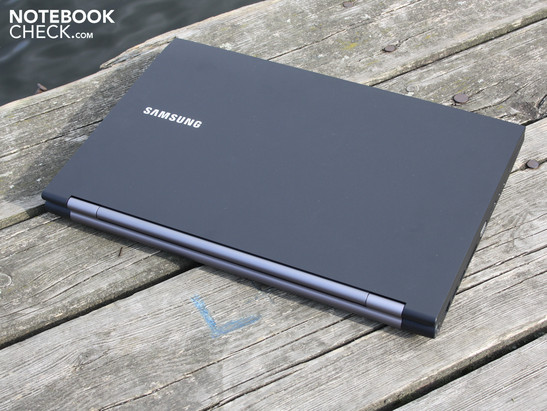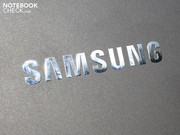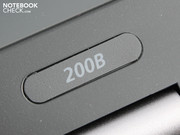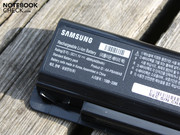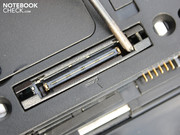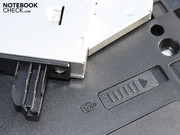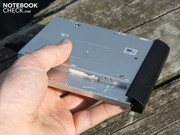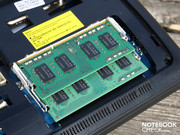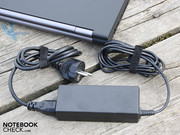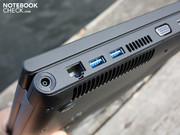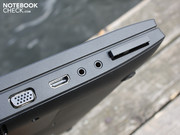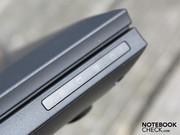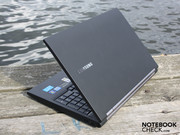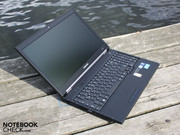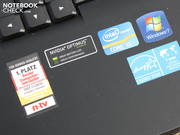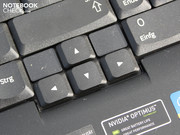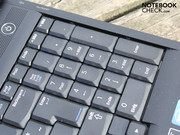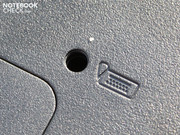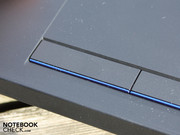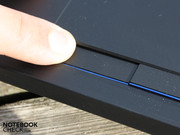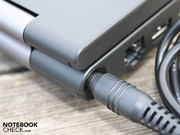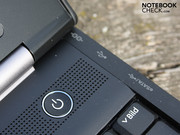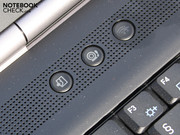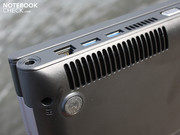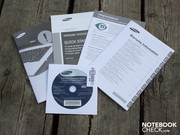Review Samsung 200B5B-S01DE Notebook

The 200B5B from Samsung's new Series 2 claims to offer "overarching perfection" and therefore the "best starter notebook" out there. The 15.6" business notebook seems to suggest excellent sturdiness with its "ultrathin, ultralight duraluminum case". What's more, the "SuperBright Plus LED Display" might end up replacing your chandelier, which means no more squinting at dimly-lit screens.
But we're not here to throw around buzz words or do Samsung's marketing for them. Rather, we aim to paint a detailed picture of the Samsung NP-200B5B in this review. For around 700 Euro you get a matte-screened 15.6" laptop whose specs are quite impressive. Among these is the docking port, the switchable graphics technology as well as various ports (USB 3.0, eSATA, ExpressCard). Beyond the specs, though, how does the keyboard feel, how much noise does the laptop make, and how sturdy is the case? We answer these and many more questions in the following in-depth review.
Case
The display lid sports a subtle matte look and a comfortable, slightly rubbery feel as does the palm rest. This means fingerprint marks are barely visible on these surfaces. The rubbery surfaces do a good job of keeping the notebook from slipping out of your hands. Those looking for a toned-down yet elegant case are in the right place.
The compact design of the case makes the impression of high quality. We unfortunately can't say the same about the case sturdiness: holding the case with two hands, the case easily twists and creaks under little pressure. It's easy to press in the area just under the DVD drive on the base plate. The case material on the flip side of the disc drive (next to keyboard) is, however, just as sturdy as the palm rest and the keyboard bed.
The display lid hinges do a poor job of keeping the display firmly in place. After opening up the notebook or adjusting the screen tilt, the display drops down a bit on its own. The loose hinges are to blame for this. Especially when the screen is open at between 80º and 160º, the display hangs so loose that it's own weight ends up pulling it down when you move the laptop. Ironically enough, a piece of metal covering the hinges is firmly attached to the case.
The stiff display lid doesn't cave in when we lightly press on it with our fingers. For as thin as the display lid is, it's rather tough. So that the display lid closes softly, a rubber strip encompasses the screen. Not even a sheet of paper can get under the rubber strip when the laptop's closed.
Connectivity
Ports
Samsung was not at all stingy in equipping the 200B5B with ports. Taking a look at the photos, we see USB 3.0 (2x), ExpressCard34 and HDMI. Even eSATA is on board, useful for connecting external hard drives at high speeds—although it's usually left out by most manufacturers when USB 3.0 is included.
The docking port is a novelty previously unseen in Samsung's inexpensive business notebook class. In the past, more expensive models like the P580 Pro Penfield did indeed sport a docking port (Station PDock, incompatible with 200B5B). Now Samsung is offering the Smart Dock (docking station) for series 2,4 and 6 laptops, which is a bit pricy at 260 Euro, though. For this sum, however, you get a DisplayPort, DVI and a Serial Com Port (RS232, 9-pin). The docking station helps preserve vital desk space by keeping cables toward the back. Even now, professionals still use RS232 for data collection.
Internet and Bluetooth
In addition to Draft-N Wifi (Broadcom 802.11n), Bluetooth 3.0+HS allows the 200B5B to wireless communicate with cell phones. The gigabit Ethernet controller (Intel 82579V) allows for extraordinary internet speeds. A built in 3G module for mobile internet use really would have been the icing on the cake, but you can't expect that at this price range.
Security
The hard drive (Hitachi HTS545050B9A300) has a motion sensor that halts the read and write heads when it senses a change from a static position (minimum 300g force). Spilling a bit of your drink onto the keyboard shouldn't be much of a problem either. The liquid simply flows through the computer and exits out the bottom. On top of that, the Support Center tool allows you to easily back up or restore your data.
Accessories
Samsung was nice enough to include a recovery disc for Windows 7 Professional (64 bit). Utilities include the SpeedUp Manager (prioritize programs in start-up), Easy File Share (access data stored on other PCs), Easy Network Manager (set up wifi connections) and Samsung Update Plus (driver updates). We particularly like the Battery Life Extender, that allows you to only use 80% of the battery life in order to improve the battery's life span (can be turned off).
Warranty
The standard warranty is 24 months (incl. on-site pick-up). The extended warranty costs 50 Euro, adding on another 12 months of coverage. If that's not enough, you can extend the warranty even further for 36/48/60 months (160, 230, 300 Euro) including on-site repair service.
Input Devices
Keyboard
The keys are raised slightly above the surrounding surface, keystrokes show a snappy pressure point and respond well. The well-separated arrow keys (slightly raised) can easily be felt out without looking. The dedicated number pad à la desktop keyboard completes the package nicely.
Typing on the keyboard is exceedingly comfortable. The keybed is very sturdy, which makes the firm keystrokes quite crisp (not hard). Each key is slightly concave, making it very easy to hit the right key. All in all, Samsung succeeds in virtually transplanting a good desktop keyboard into the 200B5B. The laptop we received did not have the keyboard backlight function advertised on Samsung's website, however.
Touchpad
The touchpad (Synaptics V7.5) makes work go by fast. The absolutely silent buttons have a rather long depression depth and are comfortable use (identisch HP ProBook/EliteBook). The slightly rubbery surface of the touchpad is the same as the surrounding palm rest and is comfortable for controlling the cursor.
The actual touchpad measures 9.7 cm in diameter. The surface remains sensitive all the way to the edges, where you can scroll horizontally or vertically. The touchpad supports all the typical multi-touch gestures. Just about all the features can be customized to your personal preferences (scrolling, gestures, sensitivity).
The HD-ready display of the Samsung NP200B5B has a resolution of a fairly low 1,366 x 768 pixels. The screen is luckily anti-glare, so you need not fear irritating reflections popping up on the screen. The resolution is rather low for a business notebook, so you'll have to make windows bigger and see less on the screen at once. A WXGA++ resolution of 1600 x 900 pixels would have been more fitting here. Especially when using programs with numerous toolbars, some of the small symbols might be hard to make out.
What's more, 200B5B's screen doesn't show a great variety of colors thanks to its low contrast. We measured a black level of 2.41 cd/m² when screen brightness was all the way up. This results from the low picture contrast of 125:1. The resulting color space is consequently quite small. The Adobe RGB (t) color space used as a reference is not even close to being replicated by the screen at hand. The same is true even for the smaller sRGB (t). Compare this with the premium-grade Samsung 900X subnotebook in the image below.
| |||||||||||||||||||||||||
Brightness Distribution: 86 %
Center on Battery: 250 cd/m²
Contrast: 125:1 (Black: 2.41 cd/m²)
37.72% AdobeRGB 1998 (Argyll 3D)
54.9% sRGB (Argyll 3D)
36.51% Display P3 (Argyll 3D)
On the lighter side of things, we have the very high maximum screen brightness of 305 cd/m². The LED backlight lights the screen up to an average of 288 cd/m². For indoor use, 150 cd/m² is enough.
Is this high screen brightness enough to counteract the powerful rays of the sun outdoors? Yeah, it is! Actually, there really aren't even many notebooks that are better in this respect. The photos below were taken under a very slightly cloudy sky. Only with strong sunlight coming in from the side does the picture become hard to make out. With that in mind, the Samsung 200B5B is excellently suited for use in the park or on the terrace of a café. The matte screen keeps reflections at bay.
The Samsung panel (LTN156AT19801) offers a very narrow range of viewing angles, which is the case for just about all inexpensive business and consumer notebooks. Looking at the screen from off to the left or the right, the picture starts to get distorted past 45º. When the tilt is 10º or more away from the ideal viewing angle, the colors quickly start to become inverted (see video below).
Performance
This 15.6" Series 2 laptop is available with an Intel Core i3-2310M (2 x 2.1 GHz). A configuration with i3-380M of the previous generation is not currently available on the market (200B5A A01). The dual-core CPU does not have Turbo Boost, but does have Hyper Threading (up to 4 threads processed simultaneously). The on-CPU Intel HD 3000 graphics card is on when little graphics-rendering power is demanded. The memory controller is also on. Via Nvidia Optimus, the system automatically switches over to the NVIDIA NVS 4200M (512 MB) dedicated graphics card when performing more graphics-intensive tasks. Compared to the more expensive Core i5 CPUs like the i5-2540M, the i3-2310M does not support AES New Instructions (encrypting and decoding).
There's 3.072 MB DDR3 RAM on board (1x 1024MB / 1x 2048MB), occupying both the available slots (DDR3 SODIMM). We can't quite put our finger on the reason for this disparity between the two RAM chips. Regardless, it doesn't cost a ton of money to upgrade to 4 GB (app. 20 Euro for a 2 GB chip). The hard drive here is a 500 GB HDD from Hitachi (HTS545050B9A300) spinning at 5400 RPM.
The i3-2310M belongs to the class of lower mid-grade CPUs, and you shouldn't expect any performance power close to that of a workstation from it. The CPU-focused benchmarks we performed show that clearly enough. In the single-core Cinebench R10 Single 64bit benchmark, the CPU earns 3,433 points. The more powerful i5-2410M (2.3GHz, Turbo) manages a better 4,510 points. What's interesting is that the higher clock-rated i3-380M (2x2.5 GHz compared to 2.1 GHz) of the Arrandale generation (previous generation) manages an almost identical 3,450 points.
When running several programs at once or programs optimized for multi-core use, multi-threading is definitely more relevant. The i3-2310M manages a respectable score here (7,285 points, Cinebench R10 Multi 64bit), higher than the i3-380M (6,233) of the previous generation. The 2011 i5-2410M and i5-2520M earn 9,451 and 10,128 points, respectively. In short, the Sandy Bridge Core i3's performance surpasses its equally clock-rated Arrandale-generation counterpart. Those looking for faster performance will want to choose a Core i5 configuration. Samsung only offers the 400B5B H01 model from the expensive Series 4 with i5 CPUs, however (starting at 850 Euro).
| PCMark Vantage Result | 4874 points | |
| PCMark 7 Score | 1570 points | |
Help | ||
PC Mark Vantage and PC Mark 7 measure overall system performance by subjecting the CPU, HDD, RAM and graphics card to realistic conditions that reflect typical use of the laptop. PCMark Vantage gives the system a score of 4,874 points, which is lower than older Samsung laptops equipped with a Core i3-380M (Samsung RV511: 5,432) and i3-370M (Samsung SF510).
In the PCMark 7 benchmark, the system earns 1,570 points, which also constitutes a relatively weak performance since an i5-2410M (Turbo Boost) notebook tested at the same time (Lifebook LH531, only Intel HD 3000) managed 1,855 points (PCMark Vantage 5,902).
| 3DMark 06 Standard Score | 4907 points | |
| 3DMark 11 Performance | 806 points | |
Help | ||
The Hitachi hard drive with a storage capacity of 500 GB, running at a moderate speed of 5400 RPM, was tested with HD Tune and Crystal Disk Mark and achieved a sequential read rate of 65 MB/s and 77 MB/s, in each benchmark respectively. The HDD Score in PCMark Vantage came to 3,515 points. The one thing that would give the 200B5B a real performance boost would be an SSD. Unfortunately, Samsung does not offer this option for their Series 2 and Series 4 laptops.
Samsung has equipped this business starter notebook with a NVS 4200M dedicated graphics card from Nvidia. This GPU is a fairly weak member of the Quadro series. What's more, these GPUs are not optimized for gaming performance (drivers, clock rates), but rather for stability and hardware compatibility for use with professional applications (CUDA, OpenCL, and Direct Compute).
Because the NVS 4200M is based on the same chip as the GeForce GT 520M, we'd expect gaming performance akin to a starter gaming notebook here. Samsung configures the system to make use of the maximum core clock rate of 810 MHz, however, which accounted for its surprising score of 4,907 in 3DMarks06. Samsung, however, did hold back on the DDR3 video memory, making use of only 512 MB of the 1GB available.
Risen & Mafia 2
Risen is a good game to test out since it's getting on in years (from late 2009) but is still pretty graphics-intensive. Even set to moderate details at a low 1024x768 resolution, the NVS 4200 has a hard time (25 fps). Playing Mafia 2, we observed the same average refresh rate of 25 fps, which makes for slightly choppy video flow at times. Compare this to the Geforce GT 540M which is found in similarly-priced consumer notebooks but achieves a frame rate of 38/40 fps (Mafia2/Risen; moderate details).
Gaming Verdict
The laptop can handle running recent to two-year-old games in low to moderate details and resolutions. Our test with Risen and Mafia 2 shows that the necessary benchmark of 30 fps is not reached with moderate detail settings. This means that games will either run choppy or you'll have to set the details very low for smooth video flow. For gaming, its better to choose a Geforce GPU: GT 540M or higher.
| low | med. | high | ultra | |
|---|---|---|---|---|
| Risen (2009) | 25.5 | 16.1 | ||
| Mafia 2 (2010) | 24.7 | 19.1 |
Emissions
System Noise
Samsung made a name for themselves in previous years with their silent notebooks. Thank to "Silent Mode", the sophisticated cooling system kept both the case temperature and noise level down to a minimum. Admirers of this cooling concept will be shocked to find no Silent Mode button anymore—this used to the be Fn-key with the whisper symbol. Nevertheless, the new Series 2 doesn't betray tradition and maintains a low (light office use) to tolerably loud noise level (heavy CPU/GPU use).
Noise level
| Idle |
| 31.1 / 31.9 / 32.1 dB(A) |
| DVD |
| 35.9 / dB(A) |
| Load |
| 35.2 / 37.2 dB(A) |
 | ||
30 dB silent 40 dB(A) audible 50 dB(A) loud |
||
min: | ||
Temperature
Under light use, the top of the base unit heats up to over 30ºC. During the stress test (Prime95 + Furmark), the temperature rises considerably. At the left of the keyboard we measured 38ºC. Near the exhaust vent, the base plate heats up to a whopping 49.5ºC.
We observed some heat-related CPU throttling during the stress test, unfortunately. For a Core i3 CPU without Turbo Boost, this comes as quite a surprise since we've mostly seen this phenomenon with Core i7 notebooks and only several Core i5 systems. During this heavy level of stress, the clock rate fluctuates between 1.5 GHz and 1.6 GHz (instead of the usual 2.1 GHz).
This throttling had no effect on any of the benchmark scores we recorded since it only arose during combined CPU + GPU stress. The stress test mentioned was performed over the course of several hours and did not result in a reduced 3DMark06 score (performed before and right after the stress test).
(+) The maximum temperature on the upper side is 38.2 °C / 101 F, compared to the average of 34.3 °C / 94 F, ranging from 21.2 to 62.5 °C for the class Office.
(-) The bottom heats up to a maximum of 49.5 °C / 121 F, compared to the average of 36.8 °C / 98 F
(+) In idle usage, the average temperature for the upper side is 26.8 °C / 80 F, compared to the device average of 29.5 °C / 85 F.
(+) The palmrests and touchpad are reaching skin temperature as a maximum (33.7 °C / 92.7 F) and are therefore not hot.
(-) The average temperature of the palmrest area of similar devices was 27.6 °C / 81.7 F (-6.1 °C / -11 F).
Speakers
The two speakers suffice for enjoying some background music or watching a film. Even though Samsung did not choose particularly high-end speakers, these are pretty good. The 2 x 1.5-watt speakers produce quite a high volume while remaining distortion-free. The bass is rather lacking, but the midrange and highs are rather well-balanced. This made for a quick listen of both Beethoven and the Bloodhound Gang equally enjoyable. As far as business-related tasks go, the volume turned up to full blast produces sound easily loud enough to fill a conference room.
Battery Life
The 15.6" laptop is equipped with a 48-Wh battery. The 200B5B can run up to 5 hours on battery power when the processor and graphics card aren't heavily used while browsing the internet (wifi test). During this test, the bright display was dimmed down to around 100 cd/m² (average). At max brightness and high CPU stress, the battery life drops down to 92 minutes.
Silent Mode is no more, but we do now have an energy-saver Fn-key that allows you to quickly select the Windows performance profile (modified by Samsung). The Endurance Mode lowers the clock rate to 800 MHz—like Silent Mode used to—in order to keep the battery going longer.
The power consumption of the Samsung 200B5B fluctuates between 15 and 58 watts (idle - stress test). The 90-watt power supply is easily able to handle this. The energy consumption while idle ranges from 15 watts (energy-saver profile, min screen brightness) to 19 watts (high performance profile, max screen brightness).
A run through 3DMark06 gets the system to eat up 49 watts, which is how much should be expected while gaming. The 58 watts we measured (battery not charging) only occurred when running Prime95 and Furmark simultaneously for our stress test.
Running Prime95 alone eats up 45 watts, while Furmark on its own needs 50 watts. The small difference (8 watts) between the combined CPU+GPU stress test and GPU-alone (Furmark) test is yet another indicator of the CPU throttling that occurs as a result of high temperature.
| Off / Standby | |
| Idle | |
| Load |
|
Key:
min: | |
Verdict
Samsung has really built up the 200B5B-S01DE with the superlative words of its advertising. Some of the claims, like those regarding the display and the battery life are completely true. But as far as case sturdiness goes, the finished product doesn't nearly meet our standards. The hinges hold the display weakly in place, the base unit creaks and is easily twisted. The similarly-priced Lenovo ThinkPads of the L-Series or HP ProBooks are a good deal better in this regard.
The heat-related CPU throttling when both the GPU and processor are under heavy stress definitely detracts from the package. However, this won't end up occurring to most users since the CPU and GPU are rarely at 100% load at once. Still, an efficient cooling system should be able to keep a Core i3-2310M's temperature within bounds, especially since it has no Turbo Boost.
No one can really expect much gaming power from a business notebook GPU: Nvidia NVS 4200 (Optimus), and the gaming tests had no surprises in store. The screen displays few colors and can be seen from few viewing angles but is matte and very bright, in return.
The keyboard and touchpad are both of excellent quality. The great variety of ports—including a docking port—allows for attaching a variety of peripheral devices at once that make you feel like a boss! The realistic battery life of 4-5 hours is also a plus, while the good speaker quality and the low temperature (elevated only under heavy use) make for a well-rounded package.
The Samsung 200B5B-S01DE is not perfect. And those desiring more might want to just dish out another hundred Euro and get a Lenovo Thinkpad L520 or HP ProBook: for example, the 2010 HP ProBook 6550b with a resolution of 1600x900, sturdy case and no CPU throttling runs for under 700 Euro.




